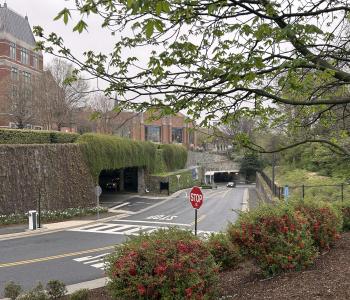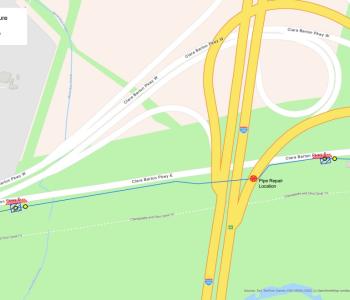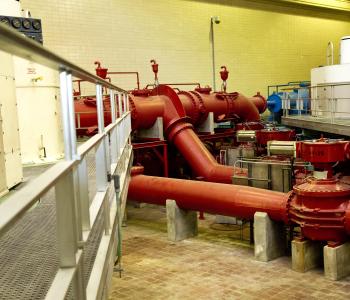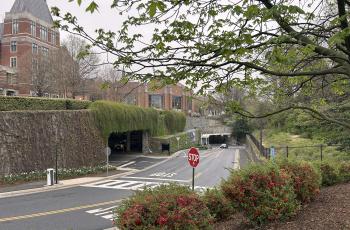DC Agreement to Implement Green Infrastructure to Control Combined Sewer Overflows Entered in Federal Court;
Today, the legal agreement to construct large scale green infrastructure (GI) to control combined sewer overflows (CSOs) to the Potomac River and Rock Creek was entered in Federal Court. The action today amends a 2005 Consent Decree between DC Water, the District of Columbia, the U.S. Environmental Protection Agency and the U.S. Department of Justice that is the basis for DC Waters 2.6 billion Clean Rivers Project.
Todays action eliminates the previously-planned underground tunnel for Rock Creek. Instead stormwater runoff will be managed through GI such as rain gardens, porous pavement installations, and rain barrels. Targeted portions of the combined sewer system in the area will also be separated. This portion of work will be completed by 2030.
For the Potomac River, DC Water will build an underground tunnel capable of holding 30 million gallons of combined stormwater and sewage. The tunnel will use gravity to allow the collected combined sewage to flow to the Blue Plains Advanced Wastewater Treatment Plant for treatment and will be completed by 2030. In addition, DC Water will construct GI and targeted sewer separation to manage runoff. The GI will be in place by 2027 and sewer separation will be complete by 2023.
The Anacostia River CSO solution, a 13.1 mile-long underground tunnel for combined stormwater and sewage storage during rains, remains unchanged. Already under construction, this work is on-budget and on-time for completion in 2022. Portions of the project will begin to provide environmental benefits as early as 2018.
I want to thank EPA, DOJ and the District Government for their willingness to be flexible and work with us to improve our original plan to generate multiple benefits for our customers and the environment, said George S. Hawkins, DC Waters CEO and General Manager. I would also like to thank our Board of Directors and our ratepayers for their resolute support and patience through the six years it took us to get to this point, and especially the DC Water staff - who have worked tirelessly to develop a program that blends grey and green infrastructure for better performance than either method would achieve alone.
In addition to helping reduce CSOs, GI can also provide additional triple bottom line (environmental, social and economic) benefits to the District. An additional agreement between DC Water and the District of Columbia is aimed to help support local job creation through the implementation of GI. The agreement, signed in 2015, will create an ambitious local jobs program that includes training and certification opportunities for District residents interested in GI construction, inspection and maintenance jobs. DC Water has established a goal to have 51% of new jobs created by the GI project filled by District residents. DC Water will also engage professional service firms and contractors based in the District to perform work associated with GI.
As in many older cities, about one-third of the District has a combined sewer system. A CSO occurs during heavy rain when the mixture of sewage and stormwater exceeds the capacity of the sewer pipes and overflows to the nearest water body. This was standard engineering design in the late 1800s and was preferable to the combined sewage backing up in homes and businesses and on the streets. Since the early 1900s, only sewer systems with separate pipes for sewage and stormwater have been installed in the District. CSOs contain bacteria and trash that can be harmful to waterways and the aquatic life they support. In an average year of rainfall, DC Waters Clean Rivers Project will decrease CSO volume by 98 percent to the Anacostia River and 96 percent to all three waterwaysthe Anacostia and Potomac Rivers and Rock Creek.
###
About DC Water
The District of Columbia Water and Sewer Authority (DC Water), is an industry leading multi-jurisdictional regional utility that provides drinking water and wastewater collection and treatment for millions of visitors, residents and employees in the District of Columbia, and also collects and treats wastewater for a population of 1.6 million in Montgomery and Prince Georges counties in Maryland and Fairfax and Loudoun counties in Virginia.
DC Waters service area covers approximately 725 square miles and the enterprise operates the worlds largest advanced wastewater treatment plant with a capacity of 384 million gallons per day and a peak capacity of 1.076 billion gallons per day. Blue Plains is also a model in sustainability, with anaerobic digesters burning sludge for combined heat and electricity and plans for green infrastructure on an unprecedented scale to reduce combined sewer overflows.








